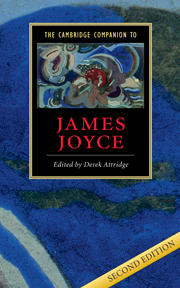Book contents
- Frontmatter
- 1 Reading Joyce
- 2 Joyce the Irishman
- 3 Joyce the Parisian
- 4 Joyce the modernist
- 5 Dubliners
- 6 Stephen Hero and A Portrait of the Artist as a Young Man
- 7 Ulysses
- 8 Finnegans Wake
- 9 Joyce’s shorter works
- 10 Joyce and feminism
- 11 Joyce and sexuality
- 12 Joyce and consumer culture
- 13 Joyce, colonialism, and nationalism
- Further reading
- Index
- Series List
1 - Reading Joyce
Published online by Cambridge University Press: 28 May 2006
- Frontmatter
- 1 Reading Joyce
- 2 Joyce the Irishman
- 3 Joyce the Parisian
- 4 Joyce the modernist
- 5 Dubliners
- 6 Stephen Hero and A Portrait of the Artist as a Young Man
- 7 Ulysses
- 8 Finnegans Wake
- 9 Joyce’s shorter works
- 10 Joyce and feminism
- 11 Joyce and sexuality
- 12 Joyce and consumer culture
- 13 Joyce, colonialism, and nationalism
- Further reading
- Index
- Series List
Summary
Far more people read Joyce than are aware of it. Such was the impact of his literary revolution that few later novelists of importance in any of the world's languages have escaped its aftershock, even when they attempt to avoid Joycean paradigms and procedures. We are indirectly reading Joyce, therefore, in many of our engagements with the past half century's serious fiction - and the same is true of some not-so-serious fiction, too. Even those who read very few novels encounter the effects of Joyce's revolution every week, if not every day, in television and video, film, popular music, and advertising, all of which are marked as modern genres by the use of Joycean techniques of parody and pastiche, self-referentiality, fragmentation of word and image, open-ended narrative, and multiple point of view. And the unprecedented explicitness with which Joyce introduced the trivial details of ordinary life into the realm of art opened up a rich new territory for writers, painters, and film-makers, while at the same time it revealed the fruitful contradictions at the heart of the realist enterprise itself.
Of course, this momentous cultural shift, which can be said to have altered the way we understand and deploy systems of representation, was not achieved single-handedly and at a stroke by James Joyce. His changing understanding of the way language relates to the world, the work of art to its cultural situation, the commonplace and repetitive in life to the remarkable and the unique, was symptomatic of a wider mutation of thought which had begun before he started writing at the very end of the nineteenth century, and had its complicated roots in the social, economic, and political transformations that occurred before and during his lifetime. But in the field of prose literature, this much broader set of movements found its most potent representative in Joyce, and his own contribution helped to determine the particular form it took in this field.
- Type
- Chapter
- Information
- The Cambridge Companion to James Joyce , pp. 1 - 27Publisher: Cambridge University PressPrint publication year: 2004
- 4
- Cited by

